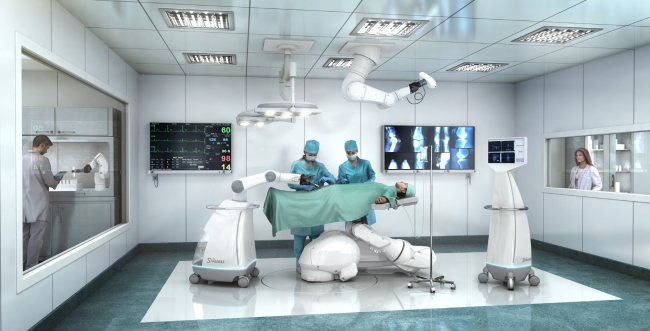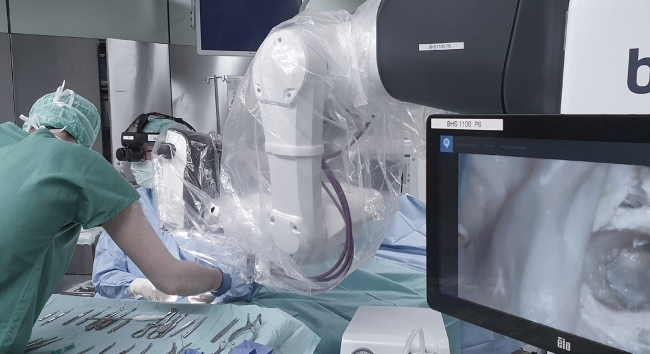5 minute read • published in partnership with Stäubli
Feature: The medical robots contributing to our wellbeing
The world of robotics grows ever larger and more diverse as the capability and flexibility of the technology advances, opening up new areas of application. The use of robots within manufacturing industry is well established and very much taken for granted, and it is not uncommon to find robots being used within the medical device and pharmaceutical sectors. However, robotics has now reached the stage where they are not only manufacturing the medicines we rely upon, they are now also now finding their way into the operating theatre, playing a crucial role in assisting surgeons with medical interventions. Simon Jenkins from Stäubli takes a look at the latest developments and advances in the company’s medical robots.
Stäubli Robotics has for many years, continued to develop robots for life science applications, and today the company’s robots are recognised as setting the benchmark for hygiene and safety. Whenever accuracy is a requirement, together with factors such as low particle emissions, and easy-clean surfaces, Stäubli has long led the way in these areas.
Simon Jenkins explains: “Stäubli has developed a unique solution that meets a number of the constraints present in patient care. Just as in our industrial focused solutions, the medical range of robots have been specially adapted to make them the perfect partner in patient care, addressing the specific demands within these high compliance and complex applications, whilst ensuring consistent performance, safety, and reliability.
Today, Stäubli robots help to relieve doctors of some of the strain they are under whilst performing operations that demand their full concentration. Our robots are also contributing to the development of innovative surgical techniques.”

Stäubli robots help to relieve doctors of some of the strain they are under whilst performing operations that demand their full concentration / Picture: Stäubli
For robots to interact with surgeons in the operating theatre, and perform the tasks demanded of them, they need to operate at the highest levels of safety. Robots within an Operating Theatre are effectively working in a collaborative manner alongside the Surgeon and other medical staff.
Stäubli robots use a unique set of modular SIL3-PLe safety functions including safe stop, safe speed, safe zone, etc. The latest TX2/CS9 systems are designed for collaborative applications with the highest levels of safety. In addition, reliable stopping and braking performance is ensured by a system embedded brake test.
Medical and patient care applications also require the highest levels of cleanliness and the company’s TX2 range of robots have a smooth, white, high-quality finish with sector specific surface preparation. This means that they are capable of meeting ISO Class 2 cleanroom standards, which demands fewer than 11 particles greater than 0.3 microns and no particles greater than 1.0 microns per cubic metre. The Stericlean range of H₂O₂ compliant robots also offer protection up to IP67 level.
Robots at the heart of clinical interventions
Stäubli has been a key player in a series of collaborations and partnerships in recent years which has seen the company’s robots working alongside Doctors and Surgeons in a number of ways.
Based in San Sebastian, Spain, Cyber Surgery has developed a robotic system for spinal procedures. The solution guides the surgeon, making the procedure safer, more accurate and minimally invasive. The three main benefits of this system are: a reduction in reinterventions due to the levels of accuracy provided by the robot, postoperative time in hospital is shortened because the surgery is performed in a minimally invasive way producing less damage to soft tissues and subsequent bleeding, and reduced X-ray exposure thanks to the fact that the robot provides a guide for the surgeon.
The RoboticScope, developed in 2016 by BHS Technologies GmbH in Innsbruck comprises of a high-precision robot, a high-resolution 3D camera, and an innovative head-mounted display.
Using this technology, the surgeon looks directly into the operating field via a Head-Mounted-Display (HMD). The two digital micro-displays integrated within the HMD directly in front of the surgeon’s eyes, show high-resolution, real-time 3D images relayed by the dual camera lenses mounted on the robot head.

RoboticScope is an intuitive system which allow the surgeon to control the image field and viewing angle through a head mounted display / Picture: Stäubli
The position of the robot determines the visible image, allowing the surgeon to operate in a freely selectable and completely relaxed head position. The surgeon retains control over the exact image field and viewing angle, automatically steering the robot with contact-free head movements. Using this method, the surgeon can select the viewing angle of the 8x zoom lenses and even control a sophisticated menu from a micro-display, allowing the activation and control of further functions. Some 500 surgeons around the world have now used the RoboticScope, and the device is so intuitive that more than 90 percent of users master it after just ten minutes.
The robot technology behind the RoboticScope is a high-precision Stäubli TX2-60L robot which delivers the precise and jerk-free motion sequences of the RoboticScope. As with the entire range of the latest 6-axis robots, the enclosed structure allows for a protection class of IP65, with the wrist being IP67 compliant. With cleanroom class ISO 5 as a standard, the robot allows BHS to also save on the potential extra costs of upgrading to a cleanroom version.
Simon Jenkins concludes: “Stäubli’s unique robot portfolio, combined with decades of industry experience, and a strong customer focus make it a valued partner for many renowned life science companies around the globe. The examples illustrated in this article are but a few of the areas where our robots are making a valuable contribution to interactive patient care.”
